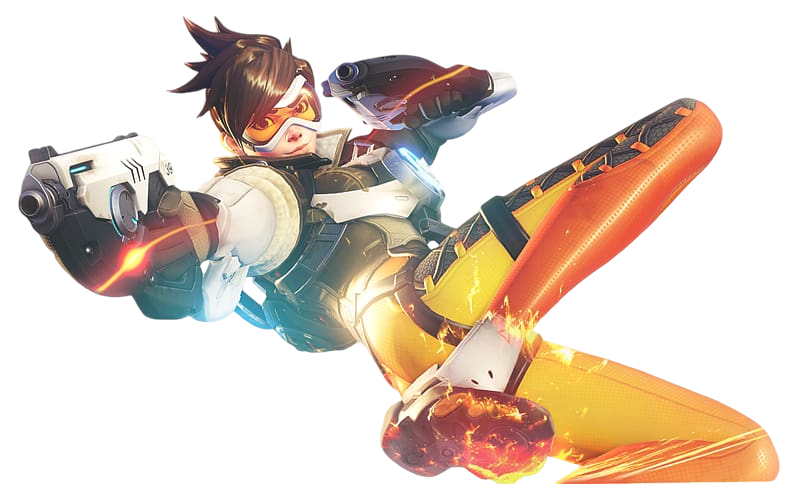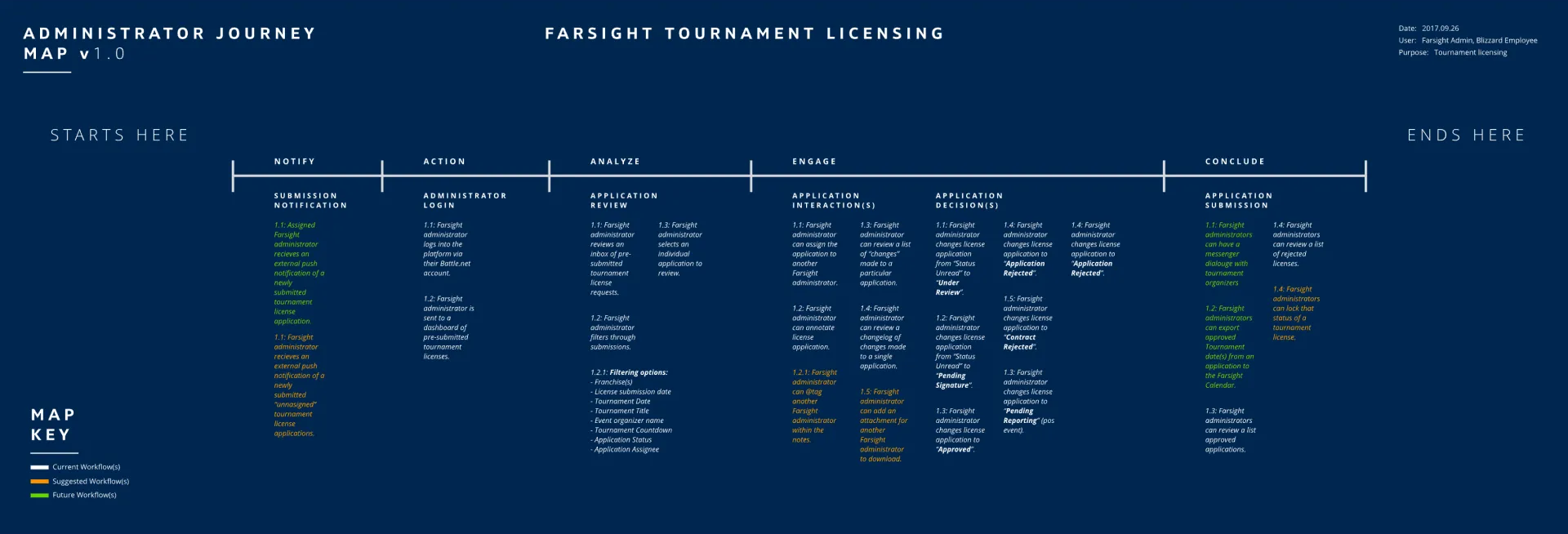Internal Operations - Desktop & Mobile
Blizzard Entertainment
Navigating Legal LOGISTICS IN THE GAMING WORLD
Due to the rising popularity of E-sports, a popular game developer found itself struggling to process tournament licensing applications at an efficient pace. The bottleneck forced an internal effort to streamline manual processes, normally handled by a small group of legal analysts. My role with Activision-Blizzard was as a contract researcher. Today’s case study covers 3 separate projects, all stemming from the same internal desire to bring external tools, internally to improve upon logistics and processes. I will be covering only 1 for the sake of brevity, but happy to go deeper upon request.
What's Your Favorite
〰️
Activision-Blizzard Game?
〰️
What's Your Favorite 〰️ Activision-Blizzard Game? 〰️
Project
Information:
Title:
Blizzard Tournament Licensing (Farsight)
Client:
Activision-Blizzard (Before Microsoft)
Vision:
Any tournament with a prize pool larger than $10,000.00 USD needs a specific license with bespoke regulations in place to monitor the results of a production, which ensures appropriate consummation of the IP.
A large influx of applications created a bottleneck, forcing multiple decision-makers to take notice. The process wasn't clearly defined, enabling many organizations to abuse community guidelines, creating a massive headache for legal.
We sought to create balance by protecting the community from harmful ramifications caused by misuse of IP while enabling them to focus on doing what they loved, gaming!
industry:
E-Sports & Gaming
Platform(s):
Desktop & Mobile
role:
Principle UX Researcher / UI Designer
Duration:
16 Months
Why this project?:
This project is one of the most unique and diverse experiences a designer can have in their entire career. Given that it was directly within a behemoth gaming giant such as Blizzard, where things historically move quite slowly, it was nice to see what a “startup” might feel like inside the walls of one of the world’s most popular game developers. There were many moving parts, multiple stakeholders, and harsh regulations that made it quite difficult to move to implement findings. It provided an excellent level of difficulty, and freedom at the same time.
Project Farsight
Starting with legal, our initial deep dive enabled us to how legal was fielding, and processing tournament license applications. Below is a sample template that sheds light on the process.
Defining the Product Vision
Most established companies will have a clear set of requirements for what they are trying to build. Even so, it was my responsibility to take the requirements, and work with the team to implement them, alongside various efforts to better understand what it was that different stakeholders needed, and if they even aligned with these requirements.
What did the legal team need to track tournament license requests?
Was there a better way of providing immediate granting for “below-threshold” licenses (Under $10k), while “high-threshold” licenses that required a deeper review?
What did Esports need to track in-game data, during these tournaments?
Like ESPN how could we better organize upcoming events and tournaments so that all stakeholders have a synchronized calendar to see and view said events if reviewing was required?
With these questions in mind (and more) we defined a list of goals that we needed to achieve in order for us to help not only the e-sports community, but also the different departments within Blizzard (Broadcasting, Service-Tech (Customer Service), Esports, and Legal).
Understanding design Guidelines
Blizzard has been around almost as long as I have been alive. There are clear design standards and rules that I was required to learn before I could start adding value. So I took some time to understand our design process and corporate usage and misuse guidelines with the team. Here are some examples >>
Understanding Customer
pain points
(Confidential Information - Please do not share under any circumstances
It was my responsibility to shadow and analyze multiple roles within each department (Esports, Legal, Broadcasting) to better understand what they were dealing with daily. In an expression of our understanding, we built out customer personas and mapped out the expected user journey on a map. Within the journey, we identified “pain points”, and opportunity locales. Some of these directly aligned with the expectations of our stakeholders, while newer opportunities were unveiled for the first time!
Articulating The Customer’s Journey
Tournament Organizers
As there was no defined process for applications outside of customer service receiving emails, our stakeholders wanted to create a portal where applicants could fill out a survey, apply, and if qualified receive a license within minutes. If they were above the $10,000 USD threshold, they would be re-routed to a legal analyst for review!
Legal Administrators
There was no dedicated role for this at the time, only analysts performing tasks, such as fielding these requests, which would often come through email. Once fielded it would be reviewed, and a decision would be made based upon specific criteria like prize pool size. However, we felt that this is a task that can be certainly automated, less any red-flags appear during the application process.
Learned Insights
During this first round of interviews and documentation, we were quickly brought up to speed on how the current process works, versus what needed to be done. There was a wide gap, and delivery timelines were tight. Below I share some of those insights that prepared us for the next phase of design.
Every deliverable we created (not fully included) was presented to our stakeholders to make them feel confident in knowing that our team(s) were making progress!
Selecting the right Blizzard Franchise
We had a team of excellent designers at our disposal. While I was focused on initial information gathering, we split off the design load between another designer and myself. They focused on wireframes, while I focused on bringing them up in fidelity, aligning them with core Blizzard design principles. Within the design shots you see above, tournament administrators could select the appropriate franchise they desired to host, and apply for the tournament through the new web portal.
(I cannot say I am a fan of so much Blizzard blue though 😅😅😅!)
Submitting applications through a dedicated portal
Once the franchise was selected, the administrator could then fill out the application, and submit it. If the application met the requirements, downloadable licenses were delivered on the spot!
Internal License
Application Review
The above images show some of the designs where an analyst would receive a notification of a new license application request. Once received, they could quickly go through it on all platforms (mobile, tablet, and desktop), review the application, and apply a series of responses to it, depending on what further information was needed to justify a decision.
Approved tournament
event calendar
If a license request was lucky enough to get the approval, the system would register the event date, and start time. This information would be stored as an event, where anyone from broadcasting, legal, and Esports could review the details of the tournament, and the IP, and even tune in to a live broadcast of said event. The primary use case for this was to enable:
An ability to view a record of tournament results, scoring, and payout should a discrepancy arise.
An ability to ensure that the documented tournament requirements aligned with the request to avoid IP abuse.
This capability needed to scale to various regions across the world, as each IP had its own legal department, depending upon which continent they were in.
CONCLUSION
This project represented one of the largest initiatives that I undertook. There were stakeholders in various departments that spanned multiple continents, multiplied by each game franchise (IP) that we served. Some moments were difficult, but it taught me how to rely on my colleagues in moments of need. Another thing it taught me was the ability to learn when to step back and allow my colleagues to step in and shine where their skill sets most align. This project was far too big for any one designer to handle, so we worked with design teams in Service Tech, Web & Mobile, and even outside contract agencies.










































